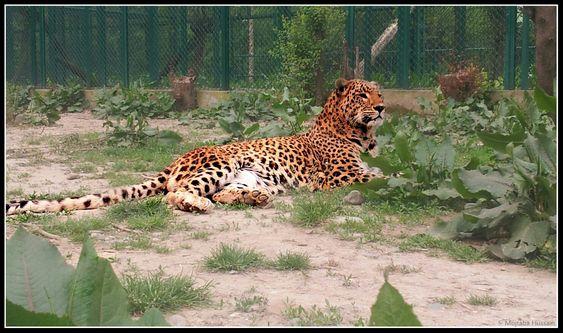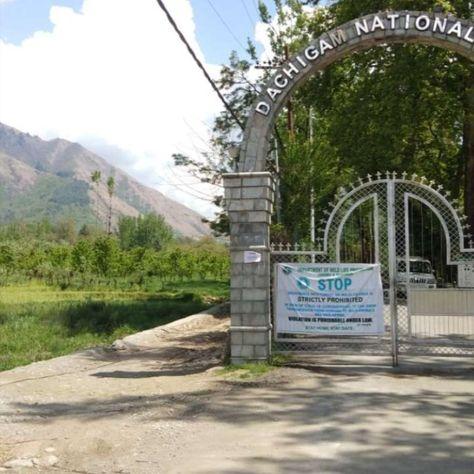



Table of Contents
- Introduction
- Geography and Topography
- Key Features
- Visiting Dachigam National Park
- How To Reach Dachigam National Park?
- Additional Transportation Options
- Activities
- Cultural Significance
- Challenges and Conservation Efforts
- Conclusion
- Faq's
Introduction
Dachigam National Park, located about 22 kilometers from Srinagar in Jammu and Kashmir, India, is a stunning natural reserve that covers approximately 141 square kilometers. The park's name translates to "ten villages," a tribute to the ten villages that were relocated to create this protected area in the early 20th century. Initially established in 1910 as a hunting reserve by the Maharaja of Jammu and Kashmir, it was later designated as a national park in 1981. The park was created primarily to ensure a clean drinking water supply for Srinagar, highlighting its ecological significance.
Dachigam is not only a sanctuary for wildlife but also an important site for conservation efforts. The park is managed under the International Union for Conservation of Nature (IUCN) category II, which emphasises the protection of natural ecosystems while allowing for public enjoyment. The diverse topography and climate of the region contribute to its rich biodiversity, making it a critical habitat for various species, including several that are endangered or endemic to the area.
 A water stream in
Dachigam National Park, Source: Pinterest
A water stream in
Dachigam National Park, Source: Pinterest
Geography and Topography
Dachigam National Park is situated in the Zabarwan Range of the western Himalayas, characterized by a dramatic variation in altitude ranging from 1,600 meters (5,250 feet) to 4,200 meters (13,780 feet) above sea level. This significant elevation change results in diverse ecosystems within the park. The landscape features gently sloping grasslands, steep rocky outcrops, and lush alpine meadows.
The park's interior is home to Marsar Lake, a high-altitude lake that serves as a vital water source for the surrounding areas. The Dagwan River flows through the park, eventually joining the Jhelum River. This river not only supports local wildlife but also provides drinking water to Srinagar via the Sarband reservoir. The varied terrain creates distinct habitats that support a wide range of flora and fauna.
Key Features
- Altitude Variation: Ranges from 1,600 m to 4,200 m.
- Terrain Types: Includes grasslands, rocky cliffs, dense forests, and alpine meadows.
- Water Sources: Home to Marsar Lake and Dagwan River
Flora and Fauna
Dachigam National Park is renowned for its rich biodiversity. It serves as a critical habitat for several endangered species, particularly the Hangul or Kashmir stag (Cervus hanglu), which is endemic to this region. Other notable wildlife includes:
 Leopard at
Dachigam National Park, Pinterest
Leopard at
Dachigam National Park, Pinterest
Mammals:
- Himalayan Black Bear
- Himalayan Brown Bear
- Indian Leopard
- Musk Deer
- Himalayan Grey Langur
- Yellow-Throated Marten
- Himalayan Wolf
- Birds: The park is a birdwatcher's paradise, hosting species such as:
- Himalayan Monal
- Bearded Vulture
- Black Bulbul
- Crimson Tragopan
The flora is equally diverse, featuring various tree species like Wild Cherry, Walnut, Chinar, Oak, and numerous flowering plants that bloom throughout the seasons. The lower elevations are dominated by coniferous forests interspersed with broadleaf trees and alpine pastures that burst into color during spring and summer.
Conservation Significance
Dachigam plays a vital role in conservation efforts due to its unique ecosystems and the presence of threatened species. The park's management focuses on habitat preservation and ecological balance to support both flora and fauna. Conservation programs have been initiated to monitor wildlife populations and maintain genetic diversity among species.
Visiting Dachigam National Park
 Dachigam National Park Gate, Source: Pinterest
Dachigam National Park Gate, Source: Pinterest
Dachigam National Park offers a unique experience throughout the year, with each season presenting its own distinct beauty and opportunities for wildlife observation. The ideal time to visit the park is from April to August, when the weather is generally pleasant, and wildlife activity peaks. However, understanding the characteristics of each season can help visitors choose the best time for their specific interests.
Spring (March to May)
Spring marks the awakening of nature in Dachigam National Park. From March to May, the park transforms into a vibrant tapestry of colors as flowers bloom and greenery flourishes. This season is particularly appealing for birdwatchers, as migratory birds return to nest, filling the air with their songs. The weather during this period is mild, making it comfortable for hiking and exploring the park's trails. Additionally, spring is significant for wildlife enthusiasts, as it coincides with the annual census of the Hangul deer population, providing a rare opportunity to observe these majestic creatures in their natural habitat. The blooming wildflowers and fruit trees add to the park's charm, making it a photographer's paradise.
Summer (June to August)
Summer in Dachigam National Park lasts from June to August and is characterized by warmer temperatures and increased wildlife activity. As snow begins to melt in the surrounding mountains, waterfalls and streams become prominent, creating picturesque landscapes that attract nature lovers. This is also the best time for spotting various mammals, including Himalayan black bears and leopards, as they are more active during these months. The lush greenery enhances visibility for wildlife spotting, and guided tours often yield exciting encounters with diverse species. The pleasant weather allows visitors to engage in activities such as trekking and nature photography without discomfort.
Autumn (September to November)
Autumn brings a stunning transformation to Dachigam National Park from September to November. During this season, the foliage changes color, painting the landscape in shades of gold, red, yellow, and orange against clear blue skies. The cooler temperatures make it an ideal time for outdoor activities like hiking and picnicking. Autumn is also a culturally rich time in Kashmir, with various festivals and events taking place that celebrate local traditions. Wildlife sightings continue to be rewarding during this period as animals prepare for winter by foraging for food. This season offers a quieter experience compared to summer, allowing visitors to enjoy the serene beauty of nature.
Winter (December to February)
Winter envelops Dachigam National Park from December to February, transforming it into a tranquil wonderland blanketed in snow. Temperatures often drop below freezing, creating a serene atmosphere where both wildlife and tourists retreat to lower altitudes. While many animals hibernate or become less active during this time, winter sports enthusiasts can enjoy activities such as skiing and snowboarding in nearby areas. The stark beauty of snow-covered landscapes provides unique opportunities for photography and solitude in nature. Visitors should be prepared for cold weather conditions but will be rewarded with breathtaking views of icy vistas and quiet trails.
Also Read: Ranthambore National Park and Fort: A Journey Through Nature and History
How To Reach Dachigam National Park?
Dachigam National Park is conveniently located near Srinagar, making it accessible through various modes of transport. This accessibility enhances the park's appeal as a prime destination for nature enthusiasts and wildlife lovers.
By Air
The nearest airport to Dachigam National Park is Sheikh ul Alam International Airport, situated approximately 40 kilometers away. This airport is well-connected to major cities across India, including Delhi, Mumbai, Bangalore, and Chennai, with regular flights operated by various airlines. Upon arrival at the airport, visitors can easily hire a taxi or arrange for a private transfer to reach the park. The journey from the airport typically takes about 1 hour, depending on traffic conditions. For those seeking convenience, many travel agencies offer packages that include transportation to and from the park as part of their services, ensuring a hassle-free experience for tourists.
By Train
For travelers preferring rail travel, the nearest railway station is Srinagar Railway Station, located approximately 32 kilometers from the park. While train services to Srinagar are limited compared to other major cities, visitors can easily reach Srinagar by train and then hire a taxi or use local transportation options to get to Dachigam. The scenic drive from the railway station to the park takes about 1-1.5 hours, allowing visitors to enjoy the beautiful landscapes of Kashmir along the way.
By Road
Dachigam National Park is well-connected by road from Srinagar, which is about 22 kilometers away. The route is accessible via national highways and state roads, making it easy for visitors to drive or hire a taxi from Srinagar. Public transportation options are also available; several buses operate between Srinagar and Dachigam National Park. Buses depart from designated terminals in Srinagar, such as the Tourist Reception Center (TRC) or Lal Chowk, offering an affordable option for budget travelers. However, it's advisable to check bus schedules in advance as services may be limited during off-peak seasons.
Additional Transportation Options
For those looking for a more adventurous approach, trekking routes lead into Dachigam National Park from nearby villages and towns. These trails offer stunning views of the Himalayan landscape but require proper planning and knowledge of the terrain. Trekking is recommended for experienced hikers who are prepared for the challenges of high-altitude trekking.
Visitors can also consider hiring private cars or taxis for a more flexible travel experience. This option allows travelers to customize their itinerary and explore other attractions in the region at their own pace. Many local travel agencies provide rental services for cars or even larger vehicles for groups, making it easier for families or larger parties to visit together.
In conclusion, Dachigam National Park's accessibility through air, rail, and road transport makes it an attractive destination for those wishing to explore its rich biodiversity and stunning natural beauty. Whether traveling by taxi, bus, or on foot, visitors can easily reach this remarkable sanctuary nestled in the heart of Kashmir.
Also Read: Top 20 Must-See Locations and Activities To Do in Hampi
Activities
Visitors can engage in several activities within the park:
- Wildlife watching
- Birdwatching
- Nature photography
- Hiking along designated trails
- The park provides opportunities for eco-tourism while ensuring that conservation efforts are not compromised.
Cultural Significance
Dachigam National Park holds cultural importance beyond its ecological value. The name itself commemorates the ten villages that were relocated during its establishment. These villages had rich histories and traditional lifestyles that are now part of local folklore. The region surrounding Dachigam has been inhabited by various communities over centuries, each contributing to its cultural tapestry.
Additionally, local traditions often emphasize harmony with nature, reflecting an understanding of sustainable practices long before modern conservation principles were established. This cultural heritage enhances visitors' experiences as they explore not only the natural beauty but also the stories woven into the landscape.
Challenges and Conservation Efforts
Despite its status as a protected area, Dachigam National Park faces several challenges related to conservation. Human encroachment due to urban expansion around Srinagar poses threats to wildlife habitats. Additionally, climate change impacts such as altered precipitation patterns can affect water sources essential for both human populations and wildlife.
Conservation efforts are ongoing to address these challenges. Initiatives include habitat restoration projects, anti-poaching measures, and community involvement programs aimed at raising awareness about biodiversity conservation. Collaboration with national institutions like the Wildlife Institute of India further strengthens these efforts by providing research support and expertise.
Conclusion
Dachigam National Park stands as a testament to nature's beauty and ecological significance. With its unique topography, rich biodiversity, and cultural heritage linked to its name, it offers an invaluable experience for nature enthusiasts and conservationists alike. As efforts continue to protect its delicate ecosystems amid growing pressures from urbanization and climate change, Dachigam remains a vital sanctuary for both wildlife and visitors seeking solace in nature's embrace.
explore further
Latest from Editorials
More from Publications
Resources
Dwello, for every home buyer, is a way to go from 'I feel' to 'I know', at no extra cost.




